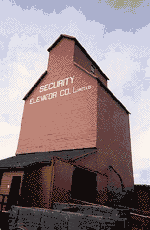|
I
am the
Yellowhead
by
Jerry W. Bird
  While
tumbleweed blow across the grassy plains
and an ocean of golden grain bows to the
wind, a few hundred miles north there is
water, water, everywhere. Some experts
claim that 100,000 lakes dot the face of
Saskatchewan. Over
half contain fish - and 90 percent of
those have never been fished. With 68
species hatching every year, small wonder
our forefathers kept a spare canoe in the
driveway. Canada's
breadbasket begins at the Saskatchewan
border, as you enter a land where the
highway meets the sky at all points on the
horizon. Just imagine these plains
inhabited by buffalo herds stretching as
far as the eye could see.
Another
common sigh on the prairies that's fast
disappearing is the familiar country
elevator, so count yourself lucky to be
traveling the Yellowhead at this time,
when they are still releatively abundant.
If you have time, stop and see how
fascinating the process of grain storage
is. While
tumbleweed blow across the grassy plains
and an ocean of golden grain bows to the
wind, a few hundred miles north there is
water, water, everywhere. Some experts
claim that 100,000 lakes dot the face of
Saskatchewan. Over
half contain fish - and 90 percent of
those have never been fished. With 68
species hatching every year, small wonder
our forefathers kept a spare canoe in the
driveway. Canada's
breadbasket begins at the Saskatchewan
border, as you enter a land where the
highway meets the sky at all points on the
horizon. Just imagine these plains
inhabited by buffalo herds stretching as
far as the eye could see.
Another
common sigh on the prairies that's fast
disappearing is the familiar country
elevator, so count yourself lucky to be
traveling the Yellowhead at this time,
when they are still releatively abundant.
If you have time, stop and see how
fascinating the process of grain storage
is.
 Throughout
the grain-growing regions of North
America, the small country grain elevator
is becoming obsolete as transportation
methods and storage needs change. Many
country elevators have been abandoned when
the equipment fails, too much maintenance
is required, or the railroad lease becomes
unaffordable. Others are destroyed when
there is a liability threat or there is a
need for a large, modern facility. As
these symbols of an earlier era of
prosperity disappear from the landscape,
so does their history if there is no
effort to document and preserve their
records and stories. The establishment of
the Country Grain Elevator Historical
Society is one way this heritage can be
preserved. Throughout
the grain-growing regions of North
America, the small country grain elevator
is becoming obsolete as transportation
methods and storage needs change. Many
country elevators have been abandoned when
the equipment fails, too much maintenance
is required, or the railroad lease becomes
unaffordable. Others are destroyed when
there is a liability threat or there is a
need for a large, modern facility. As
these symbols of an earlier era of
prosperity disappear from the landscape,
so does their history if there is no
effort to document and preserve their
records and stories. The establishment of
the Country Grain Elevator Historical
Society is one way this heritage can be
preserved.
Yorkton
Thanks to its strategic location, Yorkton
has become Saskatchewan's third largest
trading area, now serving over 250,000.
Founded in 1882 by a group representing
Ontario's York County, the early
settlement, then part of the Northwest
Territories, was relocated several miles
to the newly constructed railway line.
This move and the railway's continuing
efforts in promoting Western Canada
prepared the way to a major influx of
settlers from Europe, which added a new
vitality to the growing community and the
province.
The
promise of a homestead in Canada, with
fertile farmland and a place to grow,
became the main attraction for these hardy
pioneers, many of whom came from Ukraine.
Most had experience with farming on
similar terrain. Their hard work,
dedication and philosophy of community
cooperation and cultural pride helped
Yorkton to prosper and become the thriving
city it is today. Your first important
stop in the Province of Saskatchewan is
Yorkton, with its Western Development
Museum.
Further
down the Yellowhead is Big Quill
Lake, one of the hundred thousand we
mentioned.
Foam
Lake
From the highway you would never guess
that the Town of Foam Lake is a bustling
hive of activity. There are so many little
gems like Foam Lake along the Trans Canada
Yellowhead and unless you take a few
minutes to explore.... you may never
experience these wonderful jewels.
Community Centre. This facility has been
completely built by volunteers and is
state of the art construction with
floating hardwood floor surface for sports
or as Ray mentioned..."it's great for
dancing on"
Wynyard
to
come
Lanigan
and Watrous
. A side trip from Lanigan leads to
Watrous and Lake Manitou, (Lake of Good
Spirit), whose mineral waters rank with
Europe's great spas. After 18 holes at
Manitou Beach Club, a plunge will set you
up for dinner.
Humboldt
to
come
Side
trip: Prince Albert National
Park:
White pelicans, bald eagles, beaver,
badgers, bison, wapiti and woodland
caribou, plus numerous species of fish and
fowl -- it's like Noah's Ark. And the
hills are alive with flora; meadow rue,
prickly rose, high-bush cranberry and wild
sarsaparilla, aspen parkland and boreal
forest. Small wonder, world famous
naturalist Grey Owl, called it home. At
Waskesui Lake, a golf course, riding
stables, paddle-wheeler cruise, and
interpretive center await visitors.
Lobsticks -- trees from which Indian
trailblazers lopped off the lower
branches, mark some of the park's 140 km
of hiking path.
Saskatoon
A 'Toon' with a Berry Named After it.
"Saskatoon" is
derived from 'mis-sask-quah-toomina', the
Cree Indian name for a local indigenous
berry. The Saskatoon area has been
inhabited for some 6,000 years; however,
it was not until the summer of 1883 that
the first settlers began to arrive and
subsequently in 1903 that the town charter
was obtained. Today it is Saskatchewan's
largest city and major university centre.
The
Ukrainian Museum of Canada salutes an
ethnic group whose names appear in cities,
hamlets and hockey rinks throughout the
west. A center of scientific research,
Wanuskewin Heritage Park has an on-site
archaeological lab, diggings and trails
devoted to the Plains Indians cultural
legacy.
An
hour north of here at Batoche is a sadder
legacy -- one of civil
unrest.
A
Gattling gun, military installations, and
grave sites, give testament to the last
armed conflict on Canadian soil. An audio
visual show at Batoche National Historic
Site, north of the city, relives the days
during the 1880s Northwest Rebellion, when
Louis Reil's Metis faced off against the
British Empire.
Side
trip: Prince Albert National Park and
Waskesui Lake
The
Battlefords
Hollywood's
Mountie movies pale compared to the real
McCoy. Fort Battleford National Historic
Site is an example. Here on the Battle
River, Chief Poundmaker's Cree ransacked
Battleford, then Capital of the Northwest
Territories, sending 400 settlers
scurrying to the fort's sanctuary, and
Colonel Otter's force off in hot pursuit.
Government House,the stockade, and several
original buildings remain.
North
Battleford and nearby Fort Battleford
National Historic Site are steeped in
plains history. Here on the Battle River,
Chief Poundmaker's Cree ransacked
Battleford, then Capital of the Northwest
Territories, sending 400 settlers
scurrying to the fort's sanctuary, and
Colonel Otter's force off in hot pursuit.
Government House,the stockade, and several
original buildings remain.
Lloydminster
Yes Virginia, there is a Lloydminster,
Sask, and a Lloydminster, Alberta living
peacefully, side by side. That causes a
kaffuffle when daylight saving time rolls
around. The town's Antique Museum honors
England's Barr Colonists
Continued:
Alberta
Footnotes:
The following excerpt is from a delightful
couple from Bozeman, Montana, I had the
good fortune to meet in Vancouver at the
Grain Handling Convention several years
ago. they are dedicated to the
preservation of one of the most important
symbols on our prairies. Throughout the
grain-growing regions of North America,
the small country grain elevator is
becoming obsolete as transportation
methods and storage needs change. Many
country elevators have been abandoned when
the equipment fails, too much maintenance
is required, or the railroad lease becomes
unaffordable. Others are destroyed when
there is a liability threat or there is a
need for a large, modern facility. As
these symbols of an earlier era of
prosperity disappear from the landscape,
so does their history if there is no
effort to document and preserve their
records and stories. The establishment of
the Country Grain Elevator Historical
Society is one way this heritage can
be preserved. Throughout the grain-growing
regions of North America, the small
country grain elevator is becoming
obsolete as transportation methods and
storage needs change. Many country
elevators have been abandoned when the
equipment fails, too much maintenance is
required, or the railroad lease becomes
unaffordable. Others are destroyed when
there is a liability threat or there is a
need for a large, modern
facility.
As these symbols of
an earlier era of prosperity disappear
from the landscape, so does their history
if there is no effort to document and
preserve their records and stories. The
establishment of the Country Grain
Elevator Historical Society is one way
this heritage can be preserved.
http://www.country-grain-elevator-historical-society.org/
|
